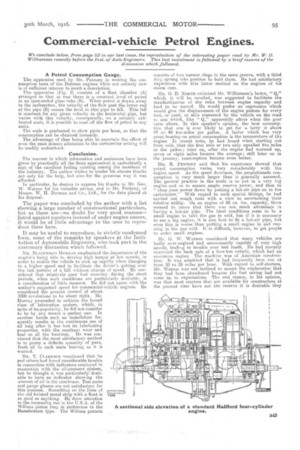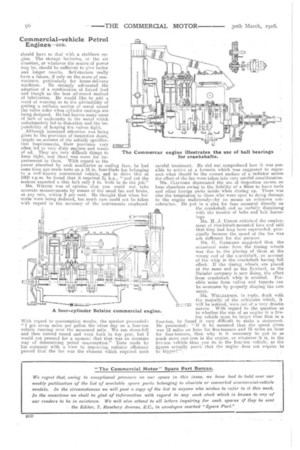Cominercial.vehicle Petrol Engines.
Page 15

Page 16

If you've noticed an error in this article please click here to report it so we can fix it.
We conclude below, from page 52 in our last issue, the reproduction of the interesting paper read by Mr. W. D. Williamson recently before the Ind, of Auto Engineers. This last instalment is followed by a brief resume of the discussion which followed, A Petrol Consumption Gauge.
The apparatus used. by Mr. Pentony in making the eonsizinption tests of the Dorman engines while not entirely new is of sufficient interest to merit a description.
The apparatus (Fig. 2) consists of a float chamber (A) arranged so that at rest there is a constant level of petrol in an open-ended glass tube (B). When petrol is drawn away to the carburetter, the velocity of the flaw past the lower end of the pipe (B) causes the level in this pipe to fall. This fall is constant for any given velocity in the horizontal pipe, but varies with this velocity, consequently, on a suitably calibrated scale, it is possible to read off the flow of petrol in any units.
The scale is graduated to show pints per hour, so that the consumption cam be obtained instantly.
The advantage of thus being able to ascertain the effect of even the most minute alteration to the carburetter setting will be readily understood.
Conclusion.
The manner in which information and assistance have been given by practically all the hams approached is undoubtedly a sign of the excellent feeling existing among the members of the industry. The author wishes to tender his sincere thanks not only for the help, but also for the generous way it was afforded.
In particular, he desires to express his thanks to Mr. Geo. W. Watson for his valuable advice and to Mr. Pentony, of Messrs. W. H. Dorman and Co., Ltd., for the data placed at his disposal.
The paper was concluded by the author with a list showing a large number of constructional particulars, but as these are—no doubt for very good reasons— listed against numbers instead of under engine names, it would be of little advantage to the user to reproduce them here.
It may be useful to reproduce, in strictly condensed form, some of the remarks by speakers at the Institution of Automobile Engineers, whotook part in the customary discussion which followed.
Mn. T. CLARNSON mentioned that he and others had found considerable trouble in connection with indicators employed in connection with the oil-pressure system, but he thought it was particularly desirable to have an indicator showing the amount of oil in the crankcase. Test cocks and gauge glasses are not satisfactory for this purpose. Something on the lines of the old twisted metal strip with a float is as good as anything. He drew attention to the increasing use in the U.S.A. of the Winans piston ring in preference to the Ramsbottora type. The Willitn.s pattern consists of two narrow rings in the same groove, with a third ring sprung into position to hold them. He had satisfactory experience with this latter method on the engines of his steam cars.
M. 0. D. NORTH criticised Mr. 'Williamson's factor, " which, it will be recalled, was suggested to facilitate the standardization of the ratio between engine 'capacity and load to be moved. He would prefer an expression which would give the displacement-. of the engine pistons for every foot, or yard, or mile traversed by the vehicle on the road to one which, like " Q," apparentlyalters when the gear ratio alters. In this speaker's opinion, tht., best consumption that one is ever likely to get for a lorry is about 47 or 48 ton-miles per gallon. A factor which has very great bearing on petrol consumption is the temperature of the engine. In recent tests, be had found when starting out from cold, that the first mile or two only equalled five miles to the gallon; later on, after the engine had warmed up, seven or eight miles became the average; still later on in the journey, consumption became even better.
MR. R. PENTONY said that his experience showed that petrol consumption varies very coneiderably with the engine speed. As the speed decreases, the proportionate consumption is very much larger than is generally assumed. The general practice in the trade is to put in a very big engine. and so to ensure ample reserve power, and then to " chop your power down by putting a hot-air pipe on to the carburetter." With regard to such special fittings, he had carried out rough tests with a view to ascertaining their relative utility. On an engine of 82 cu. ins, capacity, these seemed to prove that there was not much advantage in having a hot-air pipe. The ideal conditions seem to by a small engine to take the gas in cold, but if it is necessary to use a big engine, it is also lact to fit a hot-air pipe, but even this is worse than putting a small engine in and runruing in the gas cold. It is difficult, however, to get people to order small engines.
Mr. G. W. WATSON considered that many vehicles aro badly over-engined and unnecessarily capable of very high speeds, leading to trouble over bad roads. He had recently examined the back axle of a four-ton vehicle, which had an enormous engine. The machine was of American construction. It was admitted that it had frequently been run at from 30 to 35 miles per hour. With regard to self-starters, Mr. Watson was not inclined to accept the explanation that they had been abandoned because the fuel saving hadnot come up to expectations. The real reason, in his opinion, was that most starters that are available for constructors at the present time have not the reserve it is desirable they should have TO deal with a stubborn engine. The storage batteries, or the air chamber, or whatever the source of power may be, should be sufficient to give better end longer results. Self-starters really have a future, if only on the score of convenience, particularly for house-delivery machines. He strongly advocated the adoption of a combination of forced feed and trough as the best all-round method of lubrication. lie would like to add a . word of warning as to the advisability of getting a uniform section of metal round
• the valve sides when cylinder castings are being designed. He had known many cases of lack of uniformity in the metal which unfortunately led to distortion and the impossibility of keeping the valves tight. Although increased attention was being . given to the provision of inspection doors, „ „
largely on account of the subsidy specification requirements, their provision very often led to very dirty engines and waste of oil. They are very difficult things to "keep tight, and there was room for improvement in them. With regard to the power absorbed by such auxiliaries as cooling fans, he had some time ago made tests on a 16 in. four-blade fan belonging to a Well-known commercial vehicle, and to drive this at -1000 r.p.m. he found that it required 3 b.p., 'and yet the makers expected a thin belt only a in. wide to do the job."
MR. WILCOX was of opinion that you could not take accurate measurements by means of the usual fan and brake, at any rate, within 3 per cent. He thought that when for • make were being deduced, too much care could not be taken • with regard to the accuracy of the instruments employed.
The Commercar
With regard to consumption results, the speaker proceeded : " I got seven miles per gallon the other day on a four-ton vehicle running over the measured mile. We ran down-lull and then turned round and went bark in top gear, but I would not pretend for a moment that that was an accurate way of determining petrol consumption." Tests made by his company with a view to improving radiator efficiency proved that the fan was the element which required most careful treatment. He did not comprehend how it was possible to arrive at a formula which was suggested to represent what, should he the correct surface of a radiator unless the effect of the fan were taken into very careful consideration.
MR. CLIFFORD deprecated the use of. inspection covers on base chambers owing to the liability of a fitter to leave tools and other foreign parts inside when closing up. There was also the temptation to those who were open to doing damage to the engine maliciously—by no means an unknown consideration. He put in a plea for fans mounted directly on the crankshaft end as usefully dispensing with the trouble of belts and bat -fastenings.
MR. H. ,J. USN ER CritiCiSd the employment of crankshaft-mounted fans and said that they, had long been superseded; principally because the speed ofthe fan was not sufficient for the purpose.
M. G. GARRARD suggested that the occasional noise from the timing wheels was due to the placing of them at the wrong end of the czankshaft, on account of the whip in the crankshaft having full effect. If the timing wheels are placed at the same end as the flywheel, as the Daimler company is no-,v doing, the effect from crankshaft whip is avoided. Possible noise from valves and tappets can be overcome by properly shaping the cant entry. •
:MR. -WILLIAMSON, in reply, dealt with the _majority of the criticisms which, it will be noticed, were not of a very drastic nature. With regard to the question as to whether the size of an engine in a fiveton vehicle must be larger than that in a four-ton, he found it very difficult to make a statement. He proceeded ; "If it be assumed that the speed given was 12 miles an hour for fiye-tormers and 15 miles an hour for four-tanners, then why is it necessary to put in so much more cast-iron in the engine, or whatever it is, in the five-ton vehicle than you do in the four-ton vehicle, as the figures actually prove that the engine does not ',squire to be bigger? "






















